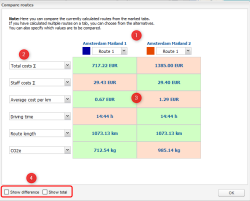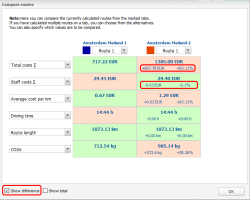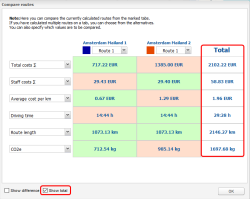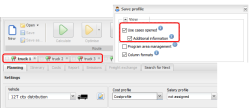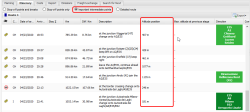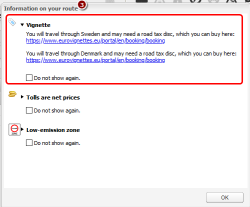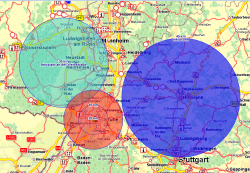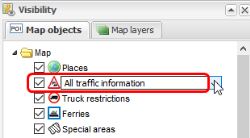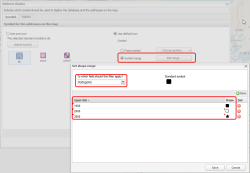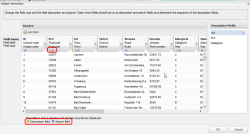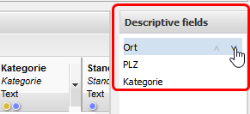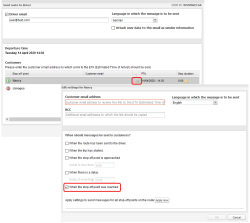What's new in TLNplanner internet?
With the new version, we offer you many functions that make working with TLNplanner internet even easier..
Route planning
Show routes from multiple tabs on the map
You can view the routes and alternate routes from up to five tabs in the map.
To do this, mark the desired tabs by clicking on the check box. The routes are shown on the map in different colors.
You can see which route on the map belongs to which tab by the color of the marker.
Tip: If the colors of the routes are difficult to distinguish, you can change the color scheme of the map. Click on  in the map and select another the color scheme, for example “Silkysand”.
in the map and select another the color scheme, for example “Silkysand”.
Compare routes from multiple tabs
The Compare routes function has been revised and improved. Up to now, it was only possible to compare routes from two tabs via CTRL + mouse click. In the new version you can mark and compare routes from up to five tabs comfortably with the mouse.
Note: The comparison via CTRL + mouse click is no longer possible.
You can compare routes, which were calculated with different vehicle profiles or routing options and display the differences. It is also possible to see the costs of an entire tour, if some parts of the tour are executed by subcontractors.
The comparison is always based on the route in the active tab. Once at least one route has been calculated, the active tab is automatically marked  and the route is displayed on the map.
and the route is displayed on the map.
-
Calculate at least two routes.
-
Click on the tab with the route that should serve as the basis for the comparison.
-
The tab is automatically marked
 and the calculated routes are displayed on the map.
and the calculated routes are displayed on the map. -
Mark the tabs whose routes you want to compare by clicking on the checkbox to the left of the route name.
-
In the toolbar click Compare.
The Compare routes window opens.
 You can use the upper drop-down lists to specify which routes are to be compared from the marked tabs.
You can use the upper drop-down lists to specify which routes are to be compared from the marked tabs.
 You can use the drop-down list on the side to specify which values are to be compared.
You can use the drop-down list on the side to specify which values are to be compared.
 The best values of the compared routes are shown in green, the bad ones in red.
The best values of the compared routes are shown in green, the bad ones in red.
 You can show the difference between the values or display the total.
You can show the difference between the values or display the total.
Difference
For all values, the absolute and percentage difference to the best and worst value is displayed.
Total
Displaying the total is helpful, for example, if a tour is run by several subcontractors with different rates.
Rename and save route planning tabs
You can change the name by double-clicking on a route planning tab. If the tabs are to be displayed again at the next start, you must save the profile.
-
In the title bar, click
 My account > Save profile.
My account > Save profile.The Save profile window opens.
-
In the View area select Use cases opened > Additional information.
-
Confirm your selection with Save profile data.
Tip: If you always want to save the current view, activate the option Automatically save profile when leaving under  My account.
My account.
Moving Tabs
You can move tabs with the mouse. Click on a tab, hold down the mouse button and move it to the desired position. If a green arrow  appears, you can "drop" the tab.
appears, you can "drop" the tab.
Calculation and display of fuel costs
In the new version, you can see exactly what fuel costs are incurred on a route. You can specify the fuel costs in the use case Vehicle management > tab Cost profiles > Edit cost profile window.
After calculating the route, the costs for the route are displayed in the Route calculation result.
Altitude data
The itinerary shows the altitude data for each waypoint and for the previous stage.
Altitude data per waypoint
Maximum altitude on previous stage
If you display only the stop-off points, the maximum altitude on the previous stage is displayed (in the example 1st stage: stop-off point 1 to stop-off point 2, 2nd stage: stop-off point 2 to stop-off point3).
In addition, the highest and lowest points of the route are displayed in the result of the route calculation.
Tip: Double-click on the highest or lowest point to display it on the map.
Vignettes
If the route leads through countries where a vignette is required, you will receive a corresponding message after the route calculation with a link through which you can buy the vignette.
Set default time slots for stop-off points
In the settings, you can define default time slots that are taken into account for each stop-off point.
-
In the title bar click
 Settings.
Settings.
-
In the navigation tree select the entry
 Route planning > Stop-off points.
Route planning > Stop-off points.
-
In the Time slot pane set up to three default time slots that will be observed at each stop-off point.
 Observe default time windows: If this option is active, the defined time slots are taken over for each new station are and are considered when calculating the route.
Observe default time windows: If this option is active, the defined time slots are taken over for each new station are and are considered when calculating the route. Use for home and destination addresses: If this option is active, the specified time windows are also taken into account for the home and destination address.
Use for home and destination addresses: If this option is active, the specified time windows are also taken into account for the home and destination address.
Copying stop-off-points via the clipboard
You can copy stop-off points to the clipboard with CTRL + C and paste them into a new or existing stop-off point list with CTRL + V.
Use case Perimeters
In the use case Perimeters you have the possibility to draw a circle around one or more addresses on the map. You can specify the radius, the color and the label.
This allows you, for example, to depict different tariff zones on the map in order to quickly provide a customer with information about the freight price.
Tip: Using the context menu of the map, you can draw perimeters in the Data Manager and Route Planning use case without opening the Perimeters use case
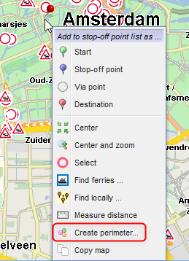
Traffic information
We have switched to another provider of traffic information that provides significantly more data.
In this turn, we removed the Traffic information use case because the list view of traffic information is not advantageous for route planning.
The traffic information is taken into account during planning as before if the corresponding routing parameter  is activated.
is activated.
Using the Map toolbar >  Visibility > Map Objects tab, you can specify whether and which traffic information is displayed on the map.
Visibility > Map Objects tab, you can specify whether and which traffic information is displayed on the map.
Note: The map displays the traffic information depending on the zoom level. If detailed data is available for a traffic information, such as the length or the expected delay, these are visualized as a tooltip when moving over with the mouse.
tender+ with multi-stop calculation
Until now, tender+ was able to automatically calculate routes from stop A to stop B using an Excel file.
In the new version we have extended the function. With tender+ you can alternatively import several stop-off points of a route and have the route calculated automatically.
We have adapted the Excel template for this purpose. Several stop-off points that belong to one tour are written row by row one below the other and are recognized as belonging together by the trip ID.
Further improvements
Data manager
-
Graphical filter for addresses
You can create a graphical filter for addresses. Using a graphical filter, addresses can be displayed on the map with different symbols, in different colors and in different sizes, depending on certain criteria such as turnover or category.
-
Marking of the description and search fields
The description fields and search fields are marked in the data manager when editing the table structure.
-
Order of the description fields
The order of the description fields can be changed when editing the data structure.
-
Checking the number of columns
When you import a csv file, the system checks whether the number of columns is correct.
Search for next
-
The list view, the arrangement of the program areas and the selected setting parameters can be saved via the title bar >
 My Account > Save profile.
My Account > Save profile. -
If you start the Search for next by clicking on the map, the nearest location is displayed as the starting point of the search instead of the coordinates.
-
You can specify that the Search for next tab is always active when opening a route planning.
-
Click
 Settings in the title bar.
Settings in the title bar. -
Select the entry Route planning > Specifications.
- Enable the option Always show ‘Search for next’ as a separate tab.
-
- Sorting in the hit list is possible via the columns.
Drive&Arrive
If you send routes to drivers, you can define when messages are sent to the customer in the Send route to driver window for each stop-off point via the  Settings. In the new version, the option When the stop-off point was reached has been added. If this option is enabled, a message will be sent to the stored e-mail address as soon as the driver has arrived at the station.
Settings. In the new version, the option When the stop-off point was reached has been added. If this option is enabled, a message will be sent to the stored e-mail address as soon as the driver has arrived at the station.
Tip: In the Sent routes use case, you can edit the settings even after the message has been sent to the driver. Right-click the SCEM ID and select Change send details from the context menu. In the Send route to driver window, you can use the settings to determine which notifications are sent for each stop-office.
Map
-
The new PTV Europe City Map Premium 2020.2H (HERE) is integrated in TLNplanner internet.
-
You can specify in the settings whether tooltips for locations are displayed on the map (Title bar >
 Settings >
Settings >  Map > Display).
Map > Display). -
In the map you can use the context menu > Copy Map to copy the current map section in a new browser tab.
-
There you can copy the graphic and paste it into a document using the clipboard.
Tip: For example, to insert the image into Microsoft® Word®, right-click at the desired location in the document and choose Insert >
 Graphic.
Graphic.
|
Copyright © 2020 PTV AG | Legal notice |

